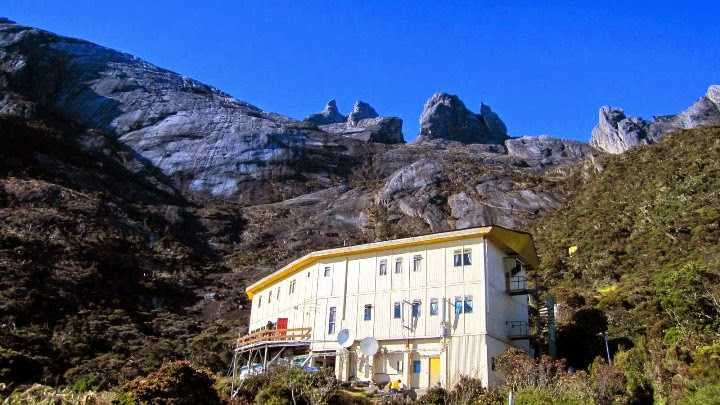Did you ever climb a mountain before?
ahhhh~ you were saying?
I currently understand with you're situation
If that’s so, let me tell you a story about Mount Kinabalu,
Sabah,
where a place you can climb eventhough you have zero experience in mountain climbing!
Believe it or NoT!!!!
Mount Kinabalu is situated in the East
Malaysia state of Sabah on the island of Borneo. It is the highest mountain
between the mighty snow-capped Himalayas and Wilhelmina (4509 meters / 14,793
feet) above sea level where you could see breathtaking sunrise from above the
clouds in Irian Jaya.
It is also one of the most accessible and spectacular
mountains in the world. Because of the earth movement, in is still growing with
the rate of 5 mm (1/4 inches) a year.
In 1964 Kinabalu Park was established to protect Mount
Kinabalu and its plant and animal life. Its 754 square kilometer (291 square
mile) terrain stretches upward from lowland rain forest to montane forest,
cloud forest and sub alpine meadow, before finally reaching a crown of bare
granite.
Only at Mount Kinabalu can you eat breakfast in a lowland rainforest,
lunch in a cloud forest, and enjoy dinner in a subalpine meadow.
The trail to the highest peak winds along the southern side
of the mountain. It is an 8.5 kilometer (5.25 mile) trek to the top and, the journey takes two days to ascend and descend Mt Kinabalu.
The Kinabalu Park Headquarters is located 90 kilometers (56
miles) from Kota Kinabalu, Sabah's capital city. More than one million visitors
have enjoyed the park since it opened.
In the year 2000, UNESCO have declared
Mount Kinabalu as The World Heritage Site.
Mt Kinabalu is one of the easiest peaks in the world to
conquer.
At sunrise, the views from the Mt Kinabalu's summit at
Low's Peak are spectacular, making all the effort worthwhile.
The eight-kilometre climb generally starts from the the Timpohon Gate
near park headquarters (1800m), with an overnight stay at one of the guest
houses at Laban Rata (3273m), before pushing on to the summit early next
morning.
Mt Kinabalu's summit is usually reached in time to view the sunrise,
before returning to Laban Rata for breakfast. Climbers then descend the
mountain, generally reaching the park headquarters by mid-afternoon.
The legends of mount kinabalu said that, until now,
Kinabalu's name is still a mystery. The most popular view derives it from the
Kadazan words, Aki Nabalu, meaning 'the revered place of the dead' or homeland for their spirit world.
The
local Kadazandusuns belief that their spirits dwell on the mountain top. Among
the bare rocks of the summit grows a moss which early Kadazandusun guides said
provided food for the spirits of their ancestor.
Another theory about the mountain's name comes from the
derivation of Kina meaning "China" and Balu, meaning
"widow".
A Kadazandusun legend tells the story of a Chinese prince
ascending the mountain. He is seeking a huge pearl on the top which is guarded
by a ferocious dragon. The prince succeeds in slaying the dragon and stealing
the pearl. He then marries a Kadazan woman, but soon abandons her and returns
to china. His wife, heartbroken, wanders to the mountain to mourn. There she
was belief to turn into stone.
Enough of the legends, let’s us come to the weather and climates in Mount Kinabalu
In the mountains it can still be quite hot during the day,
but is considerably cooler at night when the temperature at the Kinabalu Park
HQ and Mesilau can drop to 15°C (60°F).
Average temperature range from 15°C-24°C (60°F-78°F) at
Kinabalu Park HQ at 1,563m (5128 feet), where it can be quite hot during the
day but much cooler at night. At Laban Rata at 3,270m (10,728 feet) on the
summit trail, average temperatures vary from 6°C-14°C (41°F-58°F), but can
sometimes reach almost freezing at night.
Rainfall is high and often torrential, with an average of
about 2,700 millimeters (110 inches) a year recorded at the Kinabalu Park HQ
and around 3,300 millimeters (130 inches) at Laban Rata.
The best time to come to Mount Kinabalu is during the dry
season from February to April, when walking and climbing is much more
enjoyable. Dryer periods of several days also often occur in the inter-monsoon
season, between August and September.
Pick the most ideal time to conquer the mountain.
Believe in yourself.
You can do it.
Put trust in yourself.
Embrace with the challenge.
You can make the difference
See you then, at Mount Kinabalu Sabah ~^^





.jpg)
.jpg)








No comments:
Post a Comment